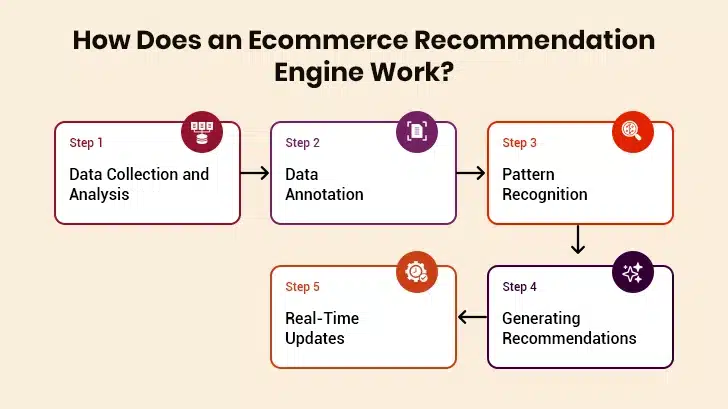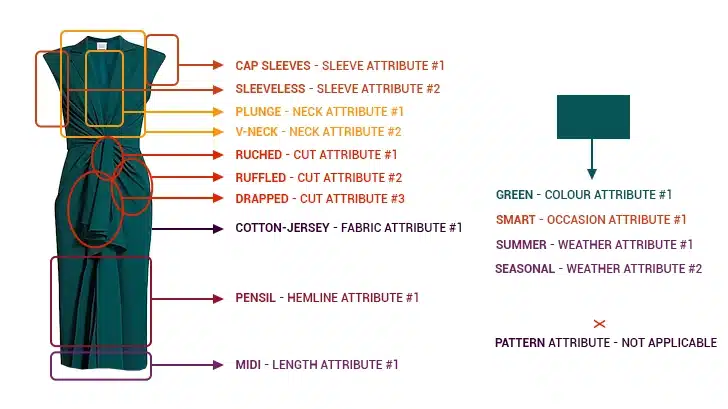Imagine logging into your company’s wholesale procurement portal and instantly seeing curated product suggestions like bulk office supplies at negotiated rates. Not only this, you can also see industrial components compatible with your machinery and AI-generated restocking alerts based on real-time inventory data. More than being a convenience, it’s just a smart sourcing engine powered by AI. And, behind every accurate recommendation? Data annotation.
Take another case of Amazon. Its recommendation engine drives 35% of the company’s total revenue. When you see “customers who bought this item also bought,” you’re witnessing millions of annotated data points working in sync. Every click, purchase, and scroll a customer makes is valuable for ecommerce businesses, as if a clue to something bigger.
All these data points are carefully labeled to train advanced AI models. In addition to tracking what the customer just purchased, these models are so powerful that they can also predict what they’re likely to buy next. This reveals the secret of how marketplaces like Amazon, eBay, and Walmart know what the customer wants!
Given this potential, it is clear why the recommendation engine market is following an upward trajectory. Currently valued at USD 9.15 billion in 2025, this figure is expected to reach USD 38.18 billion by 2030 at a CAGR of 33.06%.
Table of Contents
How Do Ecommerce Recommendation Engines Work?
What Is Data Annotation in Ecommerce?
What Are the Different Types of Data Annotation in Ecommerce?
Case Study: Netflix’s Data-Driven Recommendation Success
What Are the Other Areas Where Data Annotation in Ecommerce Delivers Value?
What Are the Challenges in Data Annotation for Ecommerce AI?
In the second quarter of 2024, ecommerce accounted for 16% of total retail sales in the United States. This is only about the US. Think of the dominance of digital commerce around the world! And in this marketplace, the customer is the literal “king.” That’s because they have multiple options to find the best deals for what they’re looking for and make the purchase.
Amidst such intense competition, ecommerce businesses have no other option but to utilize AI and ML applications such as smart recommendation engines. However, the success of these AI systems depends entirely on the integrity of their training data. This highlights the need for accurate and quality data annotation.
“More and more brands are harnessing the power of AI to implement tailored product recommendations and are seeing results. It’s estimated that 35% of Amazon’s sales come from its recommended products feature.” – Meghann York, Product Marketer, Salesforce
But what is data annotation? To be precise, data annotation is the process of tagging and labeling raw data. It is through these labels that AI systems can understand data and perform the desired actions. As a result, this training process turns machines into intelligent, customer-centric solutions. This points us to the next section: the behind-the-scenes workings of the recommendation engines used in ecommerce.
How Do Ecommerce Recommendation Engines Work?
Recommendation engines are complex systems that analyze vast datasets to predict what products a customer might want next. They use advanced algorithms, including collaborative filtering, content-based filtering and hybrid models, to understand user behavior, product attributes, and contextual signals.
Nonetheless, these systems can’t operate without accurately tagged datasets. And that’s where data annotation, specific to ecommerce, turns the tables. Through these services, each raw interaction and information gathered is labeled in a way that enables AI algorithms to detect patterns and generate accurate recommendations. Without it, even the most advanced AI model is just making guesses!
Now that we’ve understood how ecommerce recommendation engines work, let’s explore what data annotation involves and why it’s so important in this context.
What Is Data Annotation in Ecommerce?
Data annotation in ecommerce is referred as the process of accurately labeling diverse kinds of raw data, such as images, text, audio, and video, so that AI models can process and learn from it. It is through this process that recommendation engines can recognize patterns, make predictions, and deliver personalized experiences. And in the context of ecommerce, data annotation plays several essential roles, some of which are discussed below:
- Product Categorization: Consistent product annotation helps recommendation systems understand your inventory in detail. Every product image uploaded to a platform is annotated to identify important characteristics, such as color, material, brand, size, category, and more.When a customer buys a minimalist wooden coffee table, properly tagged data enables the system to relate this choice to design preferences, material interests, and even lifestyle patterns. Hereafter, making follow-up recommendations feels natural and relevant.
- Sentiment Analysis Annotation: Customer reviews and social media mentions, when annotated correctly, help the algorithms understand emotional tone, including positive, neutral, or negative. Even more, annotated reviews help AI models to look beyond star ratings. Sentiment data can highlight why a user liked or disliked a product. Was it the design, the price, or the fit? This matters because 14% of users’ revisit websites that continue to recommend items aligned with their preferences, emphasizing the role of nuanced sentiment in fostering loyalty.
- Customer Behavior Labeling: Customer behavior is another important aspect in ecommerce. Activities such as click-throughs, time spent on product pages, scrolling habits, navigation flow, and cart abandonment help understand the customer in and out. In other words, customer behavior labeling adds depth to personalization. For example, session-based annotations help AI understand where the user began their search, what caught their interest, and what made them convert (or not). What’s more, this level of labeling also enables engines to provide smarter recommendations in real time.
- Visual Search Enhancement: Isn’t it easy to find an image just by uploading a relevant picture? For this, product images are thoroughly annotated with detailed descriptions in the backend. In other words, it is product data annotation that enriches images with layers of descriptive data, helping shoppers find what they’re looking for using images.And that’s how platforms like Pinterest Lens or Google Lens provide results even when they don’t know the product name. They use annotated visual inputs to match shoppers with products, displaying results based on visual appearance.
As is evident, each of these tasks requires specific annotation methods. On that note, let’s explore the main types of annotation techniques used in ecommerce to power these functions.
What Are the Different Types of Data Annotation in Ecommerce?
Take the case of a Gantt chart. Without any color codes or task labels, it is just a block of lines, and understands priorities or dependencies through such Gantt chart is almost impossible. In terms of Gantt chart, data annotation is the color-coding and tagging that helps AI spot which tasks are urgent, which are related, and which can wait, ultimately, improves decision-making speed. Let’s take a closer look at the diverse types of annotations in ecommerce industry:
Image Annotation
- Object Detection: Products are labeled by category and subcategory. If multiple items appear in one image, each object is identified separately. For example, in an online fashion store, the main category is “clothing” and subcategories include “women’s clothing,” “men’s clothing,” and “kids’ clothing.”
- Attribute-Specific Tagging: As the name suggests, images are annotated for characteristics, such as material, color, texture, size, and style. For example, the main category is dresses. Its attributes include:
- Occasion: casual, party
- Length: maxi, mini
- Pattern: floral, solid
- Sleeve length: sleeveless, short sleeve
The Future of Image Annotation: Emerging Trends and Innovations for Businesses
Text Annotation
- Sentiment Analysis and Opinion Mining: Text-based data, such as customer feedback, product descriptions, marketing content, search queries, etc., are annotated to identify sentiments and opinions about specific features.
- Keyword and Intent Tagging: Search terms are annotated to understand whether users are researching, comparing, or want to purchase the product. For instance, “How to choose the right running shoes?”, “Samsung Galaxy S25 reviews”, and “best budget laptops under $500”.
- Entity Recognition: The process involves extracting and labeling mentions of product names, brands, and technical specifications. When a user inputs “iPhone” or “Zara” on a shopping site, they get all the relevant options with these tags.
Video Annotation
- Customer Interaction Tracking: Video footage is annotated to mark key moments of engagement and user response.
- Behavioral Pattern Recognition: Recorded sessions are analyzed to observe user flow and decision-making behavior.
- Content Verification: Videos are annotated to ensure compliance with platform guidelines and to validate authenticity.
To better understand how data annotation impacts a recommendation engine’s performance in ecommerce, let’s study the case of a company that has mastered the use of data annotation to fuel AI-driven recommendations.
Case Study: Netflix’s Data-Driven Recommendation Success
More than 80% of its viewing activities come from AI-driven recommendations. What sets Netflix apart is its multi-layered annotation strategy:
- Every title is tagged with genre, tone, narrative style, and emotional themes.
- Content complexity is scored. For example, light comedy or complex drama.
- Viewer preferences are tracked, including session timing and content that is binge-watched.
This exhaustive metadata allows Netflix to serve personalized suggestions that feel intuitive and timely, keeping users engaged and reducing churn. Just like Netflix transformed content delivery, ecommerce players are applying annotations to enhance every layer of the shopping experience. Let’s take a broader view of how annotated data supports AI workflows across the ecommerce value chain.
What Are the Other Areas Where Data Annotation in Ecommerce Delivers Value?
Data annotation isn’t just for recommendations. It also touches nearly every intelligent function within a modern ecommerce platform. Not convinced? Let’s explore what more data annotation can do in the ecommerce industry:
i. Personalize Shopping Experiences
Personalization is the fail-proof way to win battles in the marketplace as competitive as ecommerce. And there are no better options than AI systems that use annotation to transform browsing behavior into intelligent suggestions. When supplemented with contextual annotations such as session duration, device type, and engagement depth, the system can fine-tune what product to display, when to display, and how to present it.
ii. Offer Competitive Pricing
Customers want every penny spent to be worth it; thus, they compare prices across multiple platforms before making the purchase. The way out in such situations is price annotation that includes labeling competitor data with additional layers, such as promotional timing, stock availability, and product popularity.
When the AI algorithm understands how customers respond to various price points, it dynamically adjusts the pricing based on segment behavior and demand elasticity. On the tiff side, businesses can remain profitable even without charging much from customers.
iii. Chatbots and Customer Support Automation
Chatbots have turned the game upside down by interacting in ways that feel human. And what powers these chatbots is NLP-based annotation, helping them understand the intent, urgency, and emotional state of customer queries. Annotated conversation flows allow bots to respond appropriately, escalating complex cases and keeping the dialogue contextually relevant across multiple touchpoints. Thus, customers need not wait for working hours or days to get in touch with a representative.
iv. Fraud Detection and Risk Management
Transaction annotation helps AI detect anomalies, whether it’s unusual buying times, repeated failed payments, or inconsistent IP addresses. Behavioral biometrics like typing patterns or mouse movement are also annotated to create user profiles that protect against fraud, especially in account takeover scenarios.
Despite its benefits, data annotation does come with its share of hurdles. Let’s review the most pressing challenges businesses face in this space.
Explore how data annotation strengthens fraud detection in BFSI
What Are the Challenges in Data Annotation for Ecommerce AI?
As easy as it sounds, annotating datasets at scale isn’t always smooth sailing. Although there are multiple tools available to annotate ecommerce data, these aren’t always effective. Several challenges may compromise performance and scalability. Let’s take a closer look at the challenges in ecommerce data annotation:
1. Scalability Issues
The volume of data generated in modern ecommerce is overwhelming. From millions of product listings to billions of user interactions, ensuring consistency across everything is an uphill task. Not to forget, the efforts required to scale annotation while maintaining accuracy.
2. Quality and Consistency
Annotation errors, however minor, can lead to skewed predictions. Ensuring multiple annotators produce consistent, high-quality outputs requires rigorous training, standardized guidelines, and multi-stage validation.
Privacy and Ethical Concerns
Ecommerce annotations often involve personal data. Privacy laws like GDPR demand careful handling, storage, and consent mechanisms. Therefore, businesses must walk the line between personalization and data ethics. In other words, transparency and consent must be built into the annotation process.
These concerns are genuinely real. But the good news is that these issues can be easily resolved by partnering with a trusted data annotation company. Having the required experience and expertise, a dedicated ecommerce annotation company takes care of the entire pipeline. Thus, businesses can develop and deploy high-performing AI models easily.
What’s Ahead for Data Annotation in Ecommerce?
Tomorrow’s annotation practices will be smarter, faster, and more integrated into AI systems.
I. Hyper-Personalization with AI
The future of personalization lies in micro-movements. Annotating cursor patterns, scroll speed, and facial reactions, of course, with consent, will help AI adjust recommendations in real-time, even during a single browsing session.
II. AI-Generated Synthetic Data
To overcome data scarcity and privacy issues, synthetic data will play a bigger role. Generated artificially but modeled on real behaviors, it provides scalable, ethical alternatives for training AI systems. Thus, there won’t be any discrimination or bias in the outcomes.
III. Voice and Multimodal Search Optimization
As smart speakers integrate deeper into ecommerce, voice annotation will become key. Multimodal annotations that combine text, image, and voice will drive seamless product discovery, particularly in hands-free environments.
IV. Blockchain for Transparent Data Labeling
Blockchain technology brings end-to-end transparency to the annotation pipeline. Immutable records of when, how, and by whom data was annotated can ensure traceability, accountability, and compliance with evolving data standards. Thus, ecommerce businesses can harness the power of data while preserving its integrity.
Closing Lines
There’s no doubt that data annotation is the backbone of intelligent ecommerce. It allows AI to understand, learn from, and respond to human behavior in ways that feel seamless and personalized. Yet, the path to effective annotation isn’t easy. It demands scalability, consistency, ethical discipline, and a forward-looking strategy. And ecommerce companies that invest in data annotation services will certainly gain a significant edge in the industry.








